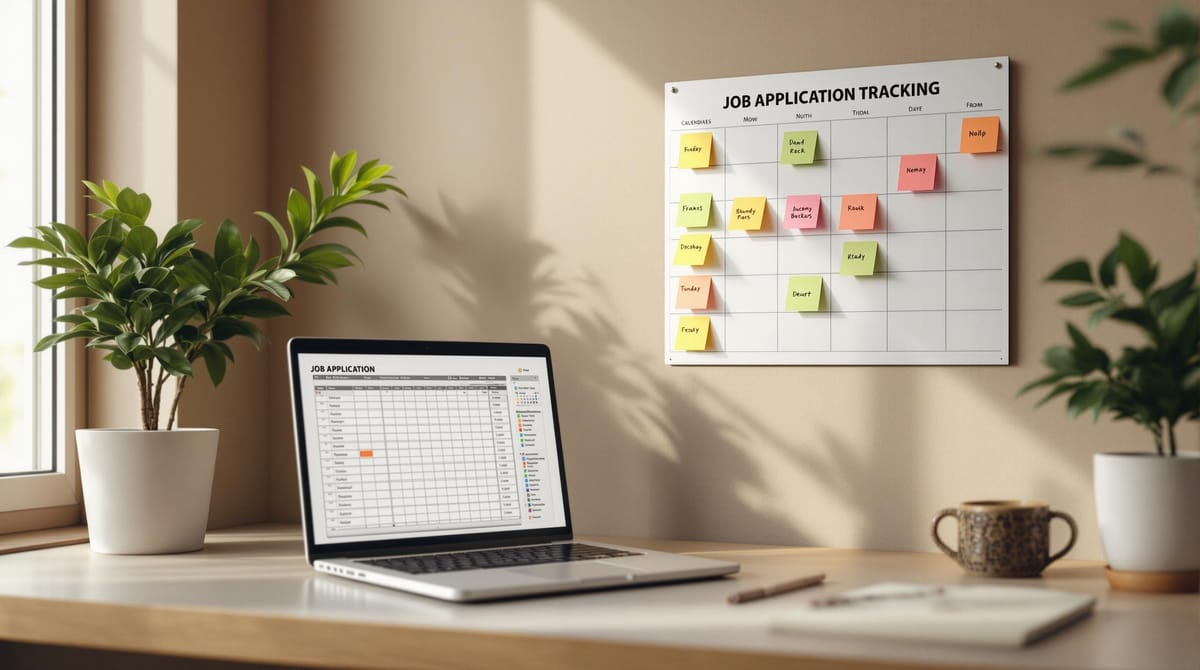How To Stay On Top Of Job Application Deadlines
Stay organized and meet your job application deadlines with effective tracking, reminders, and tools to enhance your job search success.

Managing job application deadlines can feel overwhelming, but staying organized and proactive makes a big difference. Here’s how you can stay on track and improve your chances of success:
- Use a Job Application Tracker: Keep all deadlines, company details, and follow-up dates in one place. Tools like spreadsheets or job search apps can help.
- Prioritize by Deadline: Focus on applications due soon, breaking tasks into smaller steps like research, writing, and finalizing documents.
- Set Reminders: Use calendar notifications (e.g., Google Calendar) to stay ahead of deadlines with alerts 1 week, 3 days, and 24 hours before submission.
- Create Templates: Save time by preparing reusable resumes, cover letters, and professional bios tailored for specific roles.
- Leverage Tools and Help: Use free tools for tracking and tailoring applications, or consider services like virtual assistants to handle tedious tasks.
Track Your Job Applications Using Excel Form For An Organized Approach
Step 1: Set Up a Job Application Tracker
Staying organized is key when managing multiple job applications. A centralized system helps you keep track of deadlines and prioritize your efforts effectively.
Choose Your Tracking Method
Pick the option that fits your style best:
| Tracking Method | Ideal For | Features |
|---|---|---|
| Spreadsheets | DIY enthusiasts | Customizable fields, sorting, filtering |
| Job Board Tools | Specific platforms | Automated updates on application status |
| Job Search Tools | All-in-one management | Built-in reminders, status tracking |
Essential Details to Include
Make sure your tracker captures the following:
- Company name, position, and contact details
- Application deadlines
- Current status and submitted documents
- Follow-up dates
"I applied for 183 positions in one summer - and there's no way I could've kept it all together without a way to organize and track my progress." - The Muse Author
Keep It Up-to-Date
Set aside 15 minutes each day to:
- Update the status of your applications
- Add new job postings
- Check deadlines
- Note any follow-up tasks
For the best results, update your tracker immediately after submitting an application. This ensures nothing slips through the cracks.
Once your tracker is ready, focus on prioritizing applications based on their deadlines to stay on top of your job search.
Step 2: Order Applications by Due Date
Keeping track of application deadlines is key to submitting on time and ensuring quality. A clear system can help you stay organized and avoid last-minute stress.
Sort Applications by Deadline
Set up a priority system based on how soon applications are due:
| Priority Level | Deadline Range | Action Needed |
|---|---|---|
| High | Within 7 days | Finish immediately |
| Medium | 8-14 days | Work on this week |
| Low | 15+ days | Plan for next week |
Review your list daily to focus on the most urgent applications first. This approach minimizes rushed submissions and ensures your work remains polished.
Break Down Daily Tasks
Divide application work into smaller steps like research, writing, and revisions. This makes the process more manageable and keeps you on track. Dedicate specific time slots each day for reviewing deadlines, completing urgent applications, and preparing for those due later. Build in extra time for unexpected delays to stay on top of everything.
"Breaking down application work into smaller tasks such as researching the company, drafting cover letters, and updating resumes can make the process less overwhelming. By setting daily goals, job seekers can maintain a consistent pace and ensure that all applications are submitted on time."
If juggling multiple deadlines feels like too much, tools like Scale.jobs can help. Their virtual assistants can track deadlines and create tailored application materials, freeing you up to focus on networking and interview prep.
Once your daily plan is ready, set reminders to ensure nothing slips through the cracks.
Step 3: Use Deadline Reminders
Managing job application deadlines can be stressful, but setting up reminders can make the process much smoother. It helps you stay organized without constantly worrying about missing important dates.
Set Calendar Notifications
Use tools like Google Calendar, Apple Calendar, or Microsoft Outlook to create layered reminders for each application. Here's a handy breakdown:
| Reminder Timing | Purpose | Action Required |
|---|---|---|
| 1 week before | Start preparation | Review job details and gather necessary materials |
| 3 days before | Finalize preparation | Complete your application draft and required documents |
| 24 hours before | Final review | Polish your application and double-check everything |
| 2 hours before | Submission buffer | Submit your application, leaving time for any technical issues |
Pair your calendar with tools like Trello or Asana to create a complete timeline for each application.
Enable Job Board Alerts
Job boards like LinkedIn, Indeed, and Glassdoor can send automated notifications, making it easier to track your progress:
- Application updates: Stay informed about changes to your application status or deadlines.
- New job postings: Get alerts for roles that match your preferences as soon as they're listed.
"Using calendar notifications, you can create an event for the application deadline and set reminders for 1 week, 3 days, and 1 day before the deadline. This ensures you have ample time to prepare and submit your application."
For extra help, consider tools like Scale.jobs to streamline your workflow. Check your notifications twice daily - once in the morning to plan your tasks and again in the evening to stay updated.
Step 4: Speed Up Your Applications
Making your application process more efficient helps you meet deadlines without sacrificing quality. With a few smart strategies, you can handle more applications while staying organized and effective.
Build Ready-to-Use Templates
Save time by creating templates for resumes and cover letters. Focus on these key elements:
- A master resume highlighting your main experience and accomplishments.
- A customizable cover letter framework with sections you can tweak for specific roles.
- Short professional bios for online profiles and quick applications.
Keep Your Documents Organized
Set up a clear digital filing system to access everything you need quickly. Organize files into categories like:
- Professional Documents: Different resume versions, cover letters, and references.
- Credentials: Certificates, licenses, and transcripts.
- Portfolio Samples: Examples of past work or project details.
- Additional Documents: Immigration papers, background checks, or other required forms.
Store these files in both cloud storage (like Google Drive) and on your local device for easy access and backup.
Stick to a Regular Schedule
Dedicate specific hours to your applications to stay on track. Choose times when you're most focused, like 9–11 AM, and avoid distractions. Always leave some extra time to handle any unexpected technical issues.
Once your process is running smoothly, you can explore tools and resources to make it even more efficient.
Step 5: Use Available Help and Tools
Juggling multiple job applications can feel like a full-time job itself. Thankfully, there are tools and services designed to simplify the process and keep you on track with deadlines.
Explore Free Job Search Tools
Here are a few tools that can help you stay on top of your applications:
- Resume ATS Checker: Helps you tailor your resume to pass applicant tracking systems by identifying missing keywords and fixing formatting issues.
- Cover Letter Generator: Quickly creates personalized cover letters that align with specific job descriptions.
- Job Applications Tracker: Keeps all your applications organized and integrates with other tools for better management.
These tools can save you time and help you focus on crafting quality applications. They’re especially useful for automating repetitive tasks, but sometimes, a little extra help can make a big difference.
Consider Professional Assistance
When the workload becomes too much, virtual assistants can step in to keep everything running smoothly. Services like Scale.jobs offer affordable help for job seekers:
- Time Management: Virtual assistants handle tedious tasks like filling out forms, giving you more time to prepare for interviews and network. Scale.jobs provides this service for just $4/hour.
- Tailored Documents: They create polished resumes and cover letters that are customized for each role, even under tight deadlines.
- Deadline Monitoring: Forget about missing deadlines - Scale.jobs tracks them for you and ensures timely submissions.
"Managing multiple deadlines, dealing with last-minute changes, and maintaining organization are common challenges job seekers face. However, these can be overcome by prioritizing tasks, using project management tools, and seeking help when needed." [1]
Conclusion: Stay on Track with Your Job Search
Keeping up with job application deadlines can greatly improve your chances of landing interviews and finding your next role. Career experts suggest that regularly tracking your progress and refining your approach can make you three times more likely to secure interviews compared to a disorganized, last-minute strategy.
To stay on top of things, make use of tools and support systems. Whether you're relying on free resources or services like Scale.jobs, these can help you stay organized and prioritize tasks that matter most.
Being organized isn't just about hitting deadlines - it also shows employers that you're detail-oriented and know how to manage your time effectively. These traits are highly valued and can help you stand out in a competitive job market.
It's also important to keep up your momentum without overworking yourself. Use available tools, focus on building connections, and manage your job search in a way that keeps stress to a minimum while staying productive.




